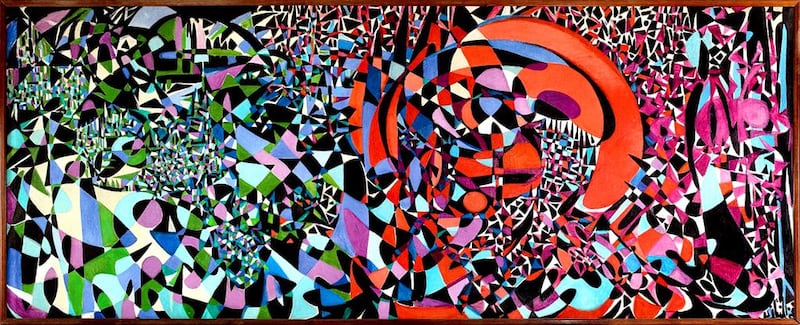DUBAI // It is one of the most expensive paintings to ever go under the hammer in the region – a huge canvas of abstract art, full of wild colours and swirling patterns.
The piece, Break of the Atom and Vegetal Life, sold for US$2.7 million (Dh9.9m), undershooting its estimate of $3m to $4m.
But visitors at the Christie’s auction in Emirates Towers on Tuesday night could not say whether the piece by celebrated Turkish-Jordanian artist Fahr El Nissa Zeid was under or overvalued.
A Dubai artist, who asked not to be identified, said: “It’s just a few squiggles. You could do this on a computer in just half an hour. It’s got no soul.
“It sold for how much it did because of who she is. A museum would be interested for that reason but it wouldn’t appeal to a private collector.”
He said the piece differed greatly from the late artist’s previous work. “I think she must have gotten excited.”
Zeid, who died in 1991, was an accomplished artist who also married into the Hashemite royal family in Iraq, giving her the title of Princess.
The piece is one of the most expensive artworks sold by Christie's Middle East.
“It’s definitely one of the strongest we’ve ever had in terms of overall value,” said the company’s regional managing director Michael Jeha before the auction. “It’s up there with the highest.”
Mr Jeha added it was difficult to establish a value for the work.
“It’s hard, there aren’t many benchmarks to compare it to,” he said. “It’s such a rare, outstanding, quality work.”
The painting dates from 1962 and is mainly a museum piece, Mr Jeha said.
It is not clear who bought it but those at the auction said it could only be a public institution.
“It’s far too big for a house,” said private collector Mohammed Fahmi. “You’d have to make a room especially with a wall big enough to display it. I think it must have been a museum.”
Another private collector, Mahmoud Farhan, said he thought the value of the piece had more to do with the name of the artist.
“It’s a beautiful piece but I’m not sure who came up with that value,” he said. “I think it’s more to do with who painted it.”
Break of the Atom fetched the second-highest price for a work by a Middle East artist. The highest was Oh Persepolis, by Parviz Tanavoli, which sold for $2.8m in 2008.
Its sister piece, Oh Persepolis II by the same artist, sold on Tuesday for $941,000. It was originally estimated to be worth between $800,000 and $1.2m.
The two pieces were sold alongside other modern and contemporary Arab, Iranian and Turkish art at the two-day auction, which concluded last night.
Thirty pieces of modern art, estimated at $7m, and 50 watches were sold on Tuesday night.
Last night, 140 pieces of contemporary art by lesser-known artists from across the region went under the hammer for a total estimated value of between $3m and $4m.
The event attracted serious buyers representing wealthy private collectors or museums but also some interested amateurs.
Sarah, an Australian who declined to give her full name, described herself as a “dabbler”.
“It’s really addictive,” she said. “I’ve got so much art, it’s all on my floor. I’ve run out of wall space.”
mcroucher@thenational.ae






